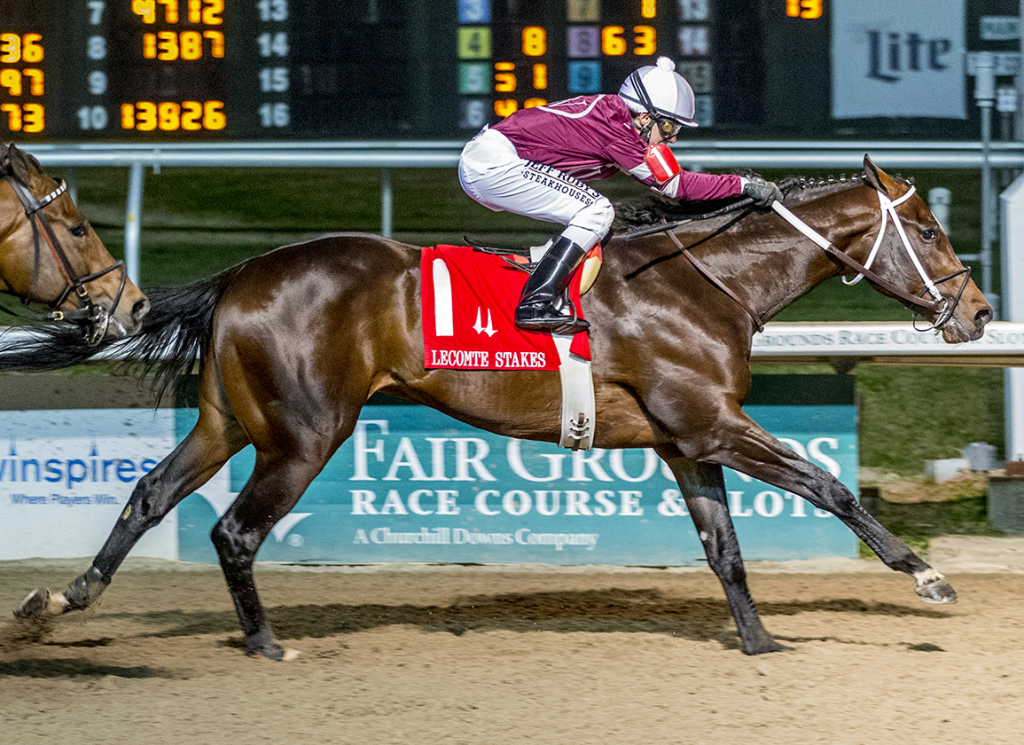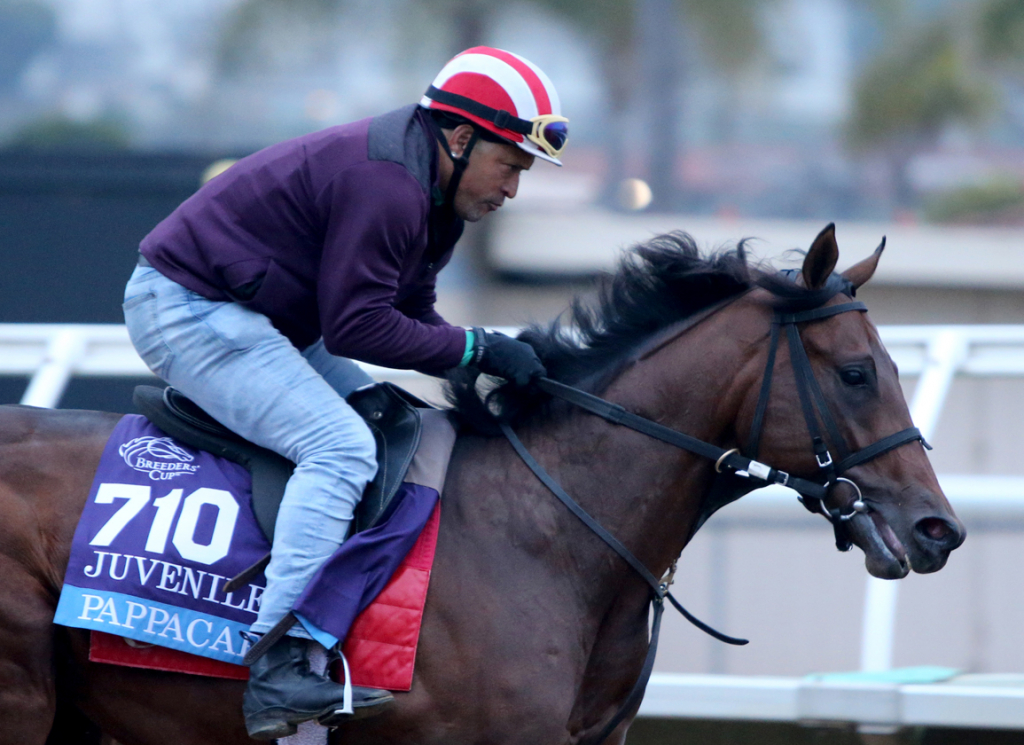Fastest two minutes in sport? You'll excuse us a bitter laugh here. By the time Mandaloun (Into Mischief) leaves the gate Saturday for the GIII Louisiana S., he'll be 382,968 minutes into a GI Kentucky Derby without end. And, with no sign of anyone putting their attorneys back in the holster, it's plainly going to be a while yet before we know whether Mandaloun will finally be anointed the 147th winner of a race that drives so many millions of dollars of investment in our industry.
(Listen to this column as an audio podcast by clicking the button below.)
As things stand, we're potentially looking at one of the luckiest animals in Turf history: a dual Grade I winner who has yet to pass the post first in a Grade I race. He was last seen, of course, in that dramatic Haskell S., which fell into his lap after Hot Rod Charlie (Oxbow) was disqualified for his tangle with Midnight Bourbon (Tiznow). The latter, conversely, has accumulated a dispiriting sequence of near-misses since his last visit to the winner's circle, on this card last year, in the GIII Lecomte S.
Given our ongoing travails, and the resulting perceptions among the wider public, our community owes a great debt to Midnight Bourbon for his balletic recovery from the brink of catastrophe at Monmouth Park. As a potential lifeline for the precarious Man o' War line, moreover, he should in due course offer another valuable service in the replication, at stud, of that extraordinary athleticism.
We're not going to run out of sons of Into Mischief any time soon, after all. One way or another, then, a lot of neutrals will be heading to Midnight Bourbon's corner as the two rivals each attempt a personal reset in what will, on the anniversary of their first, be their sixth showdown.
But you have to feel sympathy for Mandaloun, too. At the best of times, finishing second in the Derby is a bittersweet distinction. It's one that has been shared by some great names, for instance Native Dancer and Nashua within a couple of years of each other, as well as by many that can only make you scratch your head. And nobody, regardless, would want to satisfy a lifetime quest in quite this way, as connections of Country House (Lookin At Lucky) will doubtless attest.
On the day, their horse proved better equipped for the defining challenge of the American Thoroughbred than all bar one of 20,000-odd other foals in his crop. Country House was desperately unlucky to be denied any further opportunity of wresting attention from that ever-distracting horse, Maximum Security (New Year's Day). Set for a relaunch at four, only to be derailed by laminitis in February, he duly finds himself standing on most generous terms (despite being inbred to the matriarch No Class) at Darby Dan. If there's any justice, someday one of his sons will secure him overdue respect in the Derby.
If that happens, it won't be through a superior preparation. Country House was a Bill Mott masterpiece. It was only in this equivalent week that he broke his maiden; he then contested the second and third legs of the New Orleans trial series, catching the eye of many a wiseguy handicapper with the promise of better yet in the extreme test awaiting at Churchill.
In the process he contributed to the striking vigor of the Fair Grounds sophomores, in recent times. Last year the GII Louisiana Derby produced four of the first six on the first Saturday in May. True, these included a Californian shipper, but the overall strength of the Crescent City cohort certainly heightens interest in the return of Proxy (Tapit), who went missing after being sandwiched between Midnight Bourbon and Mandaloun in both the Lecomte and the GII Risen Star. Some really heartening breezes this winter allow us to hope that Proxy might yet live up to his name, and plug a gap for the Mystic Guide (Ghostzapper) barn.
But no graduate of the Fair Grounds Classic rehearsals has lately made a greater impact than Gun Runner–for whom the Lecomte, through Pappacap and Cyberknife, now represents the first big test of the theory that his stud debut was especially spectacular because his stock will emulate the way he thrived with maturity himself.
As his second-ever winner, Pappacap was among the most precocious of the surprisingly precocious gang that secured Gun Runner the freshman title; but the Rustlewood Farm homebred can be expected to consolidate on both sides of his pedigree. His mother achieved her only graded stakes placing at the end of her third campaign; his second and third dams, unusually enough, are both by sons of that doughty influence Roberto; while his fourth is by another in Pleasant Colony. In other words, this is a horse bred to stick around. (He also has the honor of starting out No. 1 on colleague T.D. Thornton's TDN Derby Top 12.)
It's a big day, then, for the Winchell family, who stand Gun Runner with Three Chimneys and will be hoping to see Midnight Bourbon elaborate his own stud credentials. Because they also present the most obvious danger to Gun Runner's Lecomte pair in Epicenter (Not This Time), whose apt emergence in the Gun Runner S. over Christmas showed him to be very comfortable with pouring the speed coals into this hot surface.
Throw into the mix Trafalgar (Lord Nelson), a promising flagship for his classy hometown barn, and this looks another instructive edition of the Lecomte S. I love the cyclical nature of the Classic trail, with all its familiar staging points, coast to coast; and the return to the same card of two of the 2021 protagonists marks another ring through the trunk of the great old Triple Crown tree.
Because it's never really just about those two breathless minutes in Louisville. Those are the tiny apex of a huge pyramid that spreads out through the patient dreams of so many different people, past and present.
With everything that's going on–condensed by the tragedy of the horse that held off Mandaloun in the Derby–we must always conduct ourselves with due respect for the generations of predecessors who made our sport what it is. This race, remember, is named for the only horse ever to beat Lexington. And if we don't prove worthy of our heritage, in the perennial quest for a Derby colt, someday we will suddenly find that it's two minutes to midnight.
The post This Side Up: Back to the Future on Lecomte Day appeared first on TDN | Thoroughbred Daily News | Horse Racing News, Results and Video | Thoroughbred Breeding and Auctions.


